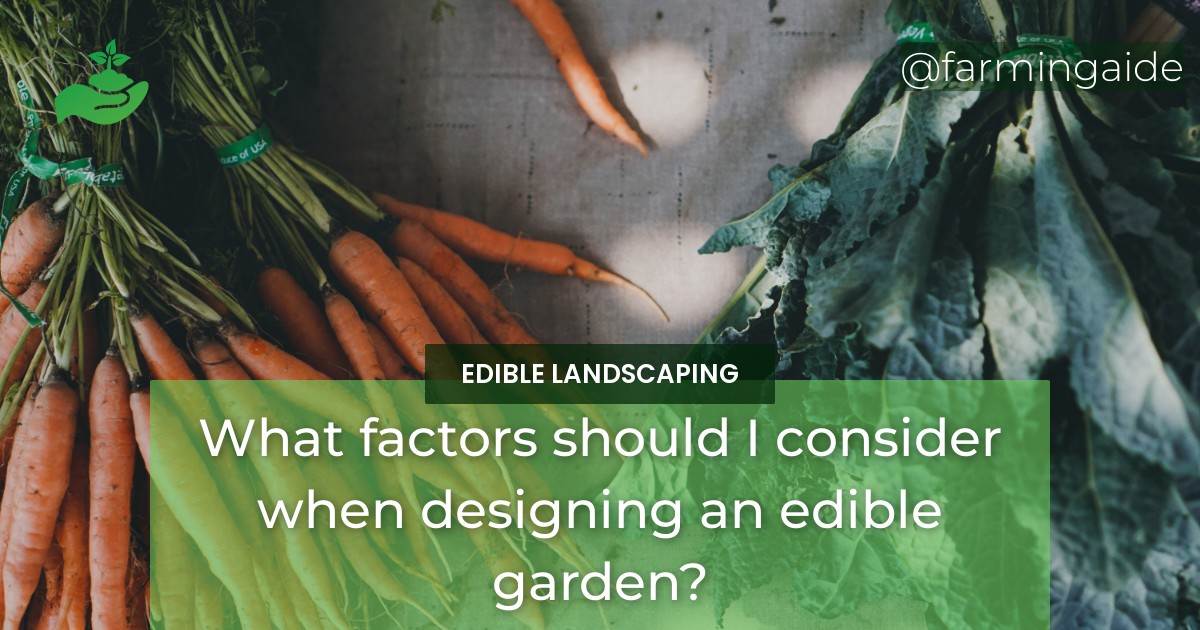Designing an edible garden requires consideration of several factors to ensure optimal results. Whether you are a beginner or an experienced gardener, understanding the key elements that make up an edible garden will help you create a garden layout that is both functional and aesthetically pleasing.
In this article, we look at the various factors to consider in edible garden design to ensure a functional garden.
Table of Contents
Factors to Consider When Designing an Edible Garden
Sunlight Requirements
Understanding the Importance of Sunlight
Sunlight is crucial for plant growth and development. Plants use sunlight to produce energy through a process called photosynthesis. The amount of sunlight required depends on the type of plant and its growth stage. Understanding the importance of sunlight will help you choose the right location for your edible garden.
How to Determine the Amount of Sunlight Needed
To determine the amount of sunlight needed, you need to know the sunlight requirements of the plants you want to grow. Most edible plants require at least six hours of sunlight per day. You can use a sun chart or a sun calculator to determine the amount of sunlight your garden will receive.
Choosing Plants Based on Sunlight Requirements
When choosing plants for your edible garden, it is important to consider their sunlight requirements. Some plants require full sun, while others can tolerate partial shade. Be sure to choose plants that will thrive in the amount of sunlight your garden receives.
Soil Conditions
Importance of Soil Quality
Soil quality is crucial to the success of your edible garden. Good soil provides the necessary nutrients, water, and air for plant growth. Poor soil quality can lead to stunted growth and poor crop yields.
Testing Soil and Making Necessary Amendments
Before planting, it is important to test your soil to determine its pH level and nutrient content. You can purchase a soil test kit or send a soil sample to a lab for testing. Based on the results, you may need to make amendments to your soil to improve its quality.
Choosing Plants Based on Soil Conditions
Different plants have different soil requirements. Some plants require acidic soil, while others prefer alkaline soil. Be sure to choose plants that will thrive in the type of soil you have.
Plant Spacing
Importance of Proper Plant Spacing
Proper plant spacing is crucial for healthy plant growth. Plants that are too close together can compete for resources and be more susceptible to pests and diseases. Proper plant spacing also ensures adequate air circulation and sunlight penetration.
Factors Affecting Plant Spacing
Several factors affect plant spacing, including the size of the plant, its growth habit, and its nutrient and water requirements.
Calculating Plant Spacing
To calculate plant spacing, you need to know the mature size of the plant and its recommended spacing. You can then use a garden planner or a measuring tape to determine the spacing between plants.
Accessible Paths
Importance of Accessible Paths in an Edible Garden
Accessible paths are important in an edible garden to provide easy access for harvesting and maintenance. They also help prevent soil compaction and damage to plants.
Factors to Consider When Designing Accessible Paths
When designing accessible paths, consider the size of your garden, the placement of plants, and your personal needs. Paths should be wide enough for a wheelbarrow or garden cart and should be made of a material that is non-slip and easy to maintain.
Materials to Use for Accessible Paths
There are several materials you can use for accessible paths, including gravel, wood chips, stone, and concrete. Choose a material that is appropriate for your garden’s design and budget.
Watering and Irrigation
Understanding the Importance of Watering and Irrigation
Watering and irrigation are crucial for plant growth and development. Plants need a consistent supply of water to thrive. Understanding the importance of watering and irrigation will help you choose the right system for your edible garden.
Types of Irrigation Systems
There are several types of irrigation systems, including drip irrigation, soaker hoses, and sprinkler systems. Each system has its advantages and disadvantages.
Choosing the Right Irrigation System for Your Edible Garden
When choosing an irrigation system, consider the size of your garden, the type of plants you are growing, and your water source. You should also consider the cost and maintenance requirements of each system.
Pest and Disease Management
Importance of Pest and Disease Management in an Edible Garden
Pest and disease management is crucial for the success of your edible garden. Pests and diseases can damage plants and reduce crop yields. Understanding the importance of pest and disease management will help you prevent and control these problems.
Preventative Measures to Minimize Pests and Diseases
There are several preventative measures you can take to minimize pests and diseases, including crop rotation, companion planting, and soil management.
Organic Pest and Disease Control Methods
Organic pest and disease control methods include using beneficial insects, such as ladybugs and praying mantises, and using organic pesticides and fungicides. These methods are safer for the environment and for the people who eat the produce from your garden.
## Harvesting and Maintenance
Importance of Proper Harvesting and Maintenance Techniques
Proper harvesting and maintenance techniques are crucial for the health and productivity of your edible garden. Harvesting at the right time and in the right way can increase yield and promote plant growth.
Harvesting Techniques for Different Types of Plants
Different types of plants require different harvesting techniques. For example, leafy greens should be harvested by cutting the entire plant, while tomatoes should be harvested when they are fully ripe.
Maintaining an Edible Garden for Optimal Results
Maintaining an edible garden involves regular tasks, such as weeding, pruning, and fertilizing. By following proper maintenance techniques, you can ensure the health and productivity of your garden.
RELATED ARTICLES:


